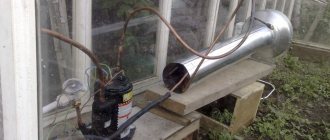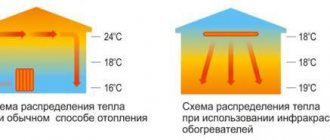With the onset of winter, traveling to the dacha, working in the garage or in other rooms where there is no heating becomes simply impossible - the low air temperature does not allow you to stay in them for a long time. Traditional electric heaters cannot always save you from the cold due to the lack of electricity. A diesel stove becomes the only way to obtain a comfortable temperature. But still, the decision to purchase a unit may be accompanied by doubts. They are associated with the buyer’s uncertainty about the quality of the stove and its safety. You should understand the operating and operation features of the unit.
Application area
Installing a miracle stove using diesel fuel will be the optimal solution for heating greenhouses, country houses, basements, utility rooms, workshops, tents, garage buildings built in places where there is no possibility of connecting to centralized heat sources.
It can be used as a permanent or additional heating device, and you can also heat tea or other food on it. A kerosene stove is more suitable for heating country houses. Its efficiency is higher than that of diesel analogues, during operation no harmful substances are released into the atmosphere, and there is no unpleasant odor.
Heating with drippers
If a drip stove is used for heating, it needs a power of at least 15-16 kW. This cannot be achieved only by increasing the drop frequency: due to the increased heat generation, the drops will evaporate while still in the supply tube. The stove (now a homemade liquid fuel boiler) will start burning with pops and then go out. Therefore, in a heating boiler using diesel fuel and exhaust, the dropper tube is connected to a flame bowl in a jacket, cooled by an air flow.
But that is not all. Due to the same greater heat release, the evaporation of fuel and combustion of vapors will be more intense. Some of the fuel vapor will be immediately thrown aside, will not burn and will begin to accumulate in the volume of the boiler, which can lead to an explosion. Therefore, a swirler is installed at the outlet of the fuel line, and the design of the deflector will be different than in a drip stove.
The diagram for connecting a homemade diesel fuel drip boiler to the heating system is shown in the figure:
Diagram of a heating system with a diesel-powered drip boiler
Air supply at power up to approx. 12 kW thermoconvection energy-independent: the intake air is first heated in the air jacket of the chimney, and then cools somewhat in the aluminum corrugated hose, which provides the necessary “suction”. At higher power, a boost from the fan is required of approx. 60 W, for example, blowing the radiator of a VAZ-2109.
Note: drawings of a drip heating boiler made from a gas cylinder with a power of up to 12 kW and an air heating furnace made of pipes for 10 kW with a cooled drip are given on the following. rice.:
Drawings of diesel fuel drip boilers for water and air heating
A significant drawback of the described system is that in order to avoid burner extinguishing and the accumulation of explosive vapors in it, the water in the boiler jacket must flow countercurrent to natural thermosiphon circulation, i.e. top down. Therefore, the system requires a circulation pump with a non-volatile (thermomechanical) automatic emergency shutdown of the boiler in the event of a power failure. All this makes this system very complex and at the same time unreliable.
It is possible to build a drip boiler for a water heating system with natural thermosiphon circulation, but in this case its design becomes more complicated and it becomes necessary to force air into the cooling jacket of the fuel line. If you definitely want to heat yourself with diesel fuel or simply nothing else, then see the following for drawings of a drip heating boiler with natural circulation of coolant in the water jacket. rice.
Drawings of a diesel fuel drip boiler for a water heating system with thermosiphon circulation
Device and elements
A kerosene and diesel fuel stove consists of the following elements:
- removable fuel tank equipped with a valve;
- housings;
- burners;
- block with a replaceable filter;
- gratings;
- adjusting screw;
- reflective screen.
The body of the diesel fuel stove is covered with a fire-resistant powder paint and varnish material, and there is a reflective stainless steel screen on it, which contributes to a more efficient process of heating the room.
A fuel tank is fixed on the rear wall, from which fuel enters the body. In it, in the very center, there is a burner mounted on a cylinder-shaped base. An adjusting screw is used to adjust the heating temperature.
Types of miracle wood burning stoves
Such devices are divided into the following types:
- potbelly stoves;
- working furnaces;
- Buleryan stoves.
If a person has skillful hands, then thanks to accurate and understandable drawings he can create different types of heating devices that can heat a small room without installing radiators or constructing a piping system.
Features of the potbelly stove
metal barrel with thick walls
The volume of such a barrel must be at least 100 liters. The point of the work is to divide the internal space of the barrel into two compartments with a horizontal metal partition no less than 5 mm thick. A hole should be cut in it to remove ash. The first compartment will be used as a combustion chamber, and the second as an ash pan.
The compartment that will be used as an ash pit is equipped with a retractable metal box where fuel combustion products will accumulate. In the front wall, using welding or a chisel, a hole measuring 40x40 cm is cut out, which will be used for the combustion chamber. Then, in the same way, cut out a hole for the ash pan, the size of which should be 10–15 cm smaller than the firebox. The firebox opening should be equipped with a door and a valve.
The top of the barrel is closed with a lid, in which a hole is made necessary for the chimney pipe. Using welding, begin to weld the lid around the entire perimeter. Then the barrel is placed on legs or a brick foundation to prevent the floor from catching fire underneath it.
This miracle wood-burning stove has its drawbacks. These include:
- low efficiency;
- fast cooling;
- it is necessary to constantly add firewood to the firebox.
But this design is considered the most economical option, and its production takes only a few hours.
Features of the Buleryan stove
The cost of such a miracle stove
In addition to the fact that the heat comes directly from the stove, warming the room, the hot air that comes out of the pipes can also contribute to this. They are necessarily present in such a design and are its distinctive feature.
Features of the furnace during mining
This miracle stove is not recommended for use in residential premises, since burning oil emits not only an unpleasant odor, but also carcinogenic substances, which are very dangerous to inhale. This design is mainly used by car enthusiasts to heat their garages. Thanks to the primitive drawings, it is easy to make it yourself.
All these stoves, despite the fact that they warm up the room very quickly, have such disadvantages as low productivity, the need for constant control over the process of burning wood and the systematic addition of fuel.
Advantages and disadvantages
The advantages of diesel stoves for heating are:
- small dimensions;
- mobility;
- availability of fuel and its low consumption;
- no open flame;
- intensity adjustment;
- no costs for the construction of a permanent chimney;
- acceptable price.
The disadvantages include:
- periodic replacement of wicks;
- frequent burner cleaning;
- A diesel fuel stove is not recommended for heating residential premises as a permanent heating device, since the smell of diesel fuel may be felt in the room and acrid smoke may enter when ignited or extinguished.
Reviews
Consumers love miracle liquid fuel stoves. People find them practical and convenient. Used to heat garages, barns, and other household items. buildings
They note, however, that using a stove as a stove is not effective; cooking “is the same as using a radiator.” Food heats up much faster if you light a fire or use a burner with an open flame while camping. Another note is about the fuel supply control system.
Penza Solar Gases use a primitive, very inert method. In addition, the tap is not equipped with seals; air is sucked in, which leads to combustion instability. For example, Japanese liquid fuel stoves operating on the same principle are much better designed and easier to regulate.
How to do it yourself?
Models of stoves for heating with diesel fuel, which can be bought in a store, are designed for a certain thermal power and are capable of heating a building with an area of no more than 30 m2. A home-made device will be more economical and ideal for the intended operating conditions.
Materials and tools
When building a diesel and kerosene stove with your own hands, you can use a used cylinder for storing and transporting liquefied propane-butane gas as a basis.
In addition, you need to prepare:
- a pipe for making a chimney no less than 4 meters long, with an internal diameter of 10 cm and a wall thickness of 2 mm;
- a copper tube about 1.5 m long;
- a small clamp with a screw;
- two-liter medical heating pad;
- angle steel 20x20 mm;
- electrodes.
The set of tools should consist of:
- welding machine;
- drills and drill bits;
- file;
- Bulgarians;
- rulers and tape measures.
1 production option
Scheme of a miracle diesel stove
- drain the remaining filler from the cylinder;
- wash it with a weak soap solution, and then with clean water and dry well;
- Use a grinder to cut off the top part, remove the valve and weld a smoke exhaust pipe in its place;
- Weld angle steel legs to the lower half (firebox) and cut a hole on the side for installing a copper tube;
- cut another hole in the housing to regulate air flow and cover it with a metal plate;
- bend the copper tube at an angle of 90 degrees, connect one end to the rubber hose from the heating pad, place the other in the cylinder;
- bend the hose in half, use a clamp with a screw to secure the bend;
- fill the heating pad with diesel fuel and hang it on the wall away from the device;
- place a cup of fuel in the combustion part, making sure that the end of the copper tube is located directly above this container;
- place a lit piece of paper in a cup on top of the diesel fuel;
- connect both parts of the cylinder;
When heated, the diesel fuel will begin to evaporate, followed by spontaneous combustion of the vapors. You can add fuel using a heating pad. From it, fuel flows drop by drop to a copper tube through a rubber hose, and then enters the firebox. To adjust the feed, a screw on the clamp is used.
Manufacturing option 2
Here is the second manufacturing option:
Scheme
Dimensions
Appearance
General recommendations
When assembling a heating unit yourself, you should remember that liquid fuel stoves belong to the dangerous class, especially a gasoline stove. Increased attention and compliance with basic safety precautions is required.
In addition to the risk of fire, there is a high risk of carbon monoxide poisoning. Therefore, in rooms where there is poor ventilation and air circulation is severely limited, it is preferable to use other, safer heating options.
It would be useful to install a separate pipe for exhausting gases, which will extend outside the room. At a minimum, such an action can significantly reduce the unpleasant odor and increase the removal of combustion products.
In any case, if it is not possible to use safer heating options and heat with gas or electricity, then a solar autonomous heater will be an ideal option if you follow simple rules.
In this video about a diesel stove:
Waste oil burners
They attract those who have access to this type of fuel. Although it is not so easy to make a burner, you need to use it with great care, but it gives its efficiency and does not lose popularity in its circles.
Long burning stoves
These are small stoves that allow you to create air heating. They run on good quality solid fuel.
Special convection pipes on their sides draw in and warm the air, accelerating its circulation in the room.
Well-known models of this type: Buleryans, Brenerans, Butakovs, Termofor, Teplodar, Burzhuy-k, Besser.
So, whether a stove is good in comparison with other options can only be judged if you select two units for the same purpose.
For example, electric heaters can produce a third more power for the same cost, and some boilers can run on waste wood, which is much cheaper.
However, kerogen gas (and modern solar gases are those same kerogen gases) was not developed with the goal of reducing costs to a minimum, but as a portable and compact travel option. And I must say, it turned out to be a really convenient and safe stove.
Bubafonya is one of the variations of a long-burning stove. Making a Bubafonya stove does not require a lot of materials or time, so many craftsmen prefer to assemble the structure themselves rather than buy a ready-made version.
What is a muffle furnace and how to make it yourself, read on.
Ready-made models
Among the most common liquid fuel heating appliances is a miracle - the Solarogaz stove, made in Russia (Penza, PA "Savo"). The products of this association have different configurations and sizes, differences in the material of the burner and shell and, accordingly, in price.
Thermal power ranges from 1.8 kW to 5 kW, depending on which such a miracle - a diesel stove can heat a room with an area of 18 to 50 square meters.
Solar gas PO-1.8
So, for example, a mini stove using diesel fuel from this manufacturer Solarogaz PO-1.8:
- made with dimensions 27x37x28 cm;
- has a fuel tank with a volume of 2.5 liters and a weight of 5.5 kg;
- can be fueled not only with diesel fuel, but also with kerosene;
- its power is 1.8 kW, fuel consumption is 0.2 l/hour.
Designed for heating a small room, the area of which is no more than 18 square meters. m. You can buy such a miracle - a diesel fuel stove for 2 - 2.5 thousand rubles.
Solar gas Duet 5.0
The more powerful device Solarogas Duet 5.0 costs more, from 4.5 to 6.0 thousand rubles, since its power rating corresponds to 5 kW. It has:
- overall dimensions – 37x42x32 cm;
- fuel tank volume – 5 l;
- fuel consumption – 0.2 – 0.4 l/hour;
- burning time before refueling is about 28 hours.
Recommended for heating warehouses and utility rooms with an area of up to 50 square meters. meters.
Aeroheat HA S2600
Popular models also include the Aeroheat HA S2600 kerosene and diesel fuel stove with a glass shell.
The technical characteristics of these heating devices are as follows:
- thermal power – 2.6 kW;
- fuel tank volume - 2.5 l;
- burning time before the next refueling is from 8 to 12 hours;
- dimensions - 35x29x27 cm;
- weight - 4.8 kg;
- fuel consumption - from 0.18 to 0.2 kg/hour.
TRITON 8.7
Powerful Hungarian diesel stoves for cottages, brand TRITON 8.7, with a water circuit and a hob, depending on the power, are capable of heating a room of up to 250 m2. They have high efficiency; a dispenser is used to regulate the fuel supply. The cost varies from 18.0 to 45 thousand rubles.
About diesel heat guns
Heating units of this type are designed to heat large areas (from 30 m²) in all weather conditions. A diesel stove is a warm air blower in the form of a pipe mounted on wheels for ease of movement. A turbine built at the end of this pipe is responsible for creating the air flow. The burner for the stove, which burns diesel fuel, is placed inside the combustion chamber and is washed with air from all sides. There are 2 types of heat guns:
- Directly heated. This means that the air passing through the pipe is heated by the walls of the chamber and mixed with the combustion products coming out from there, and then the mixture of gases enters the room. The heater is very efficient, but is not suitable for use in confined spaces.
- With indirect heating. The design is similar to the first, but the exhaust gases are not mixed with the air flow and are directed through a separate channel into the chimney, as shown in the diagram. The heater loses efficiency, since part of the heat is lost along with combustion products, but it is absolutely safe and is capable of heating living spaces.
Diagram of operation of a diesel gun with direct heating of the air flow
Note. Due to their design, heat guns are dependent on the supply of electricity. Without it, the fan and automatic heater will not turn on.
Let us list the main advantages of diesel-fired air stoves:
- the ability to heat large areas, for which models with a power of 10 to 100 kW are produced;
- acceptable diesel consumption;
- mobility;
- maintaining the required air temperature in the room;
- automatic safety system that turns off the pump and fuel supply to the nozzle in case of overheating, power outage and other emergency situations;
- high speed of heating the entire volume of the room.
Operating principle of a diesel fuel air heater with a chimney
An example regarding fuel consumption. The well-known manufacturer of climate control equipment Ballu claims the following indicators: a 20 kW unit consumes 1.6 kg/h of diesel fuel (about 2 l), 30 kW – 2.4 kg/h (up to 3 l), and a 50 kW heater “eats” 4 kg/h diesel fuel (up to 5 l).
The main disadvantage of powerful diesel heaters is their high cost. Take products from the same brand Ballu, which is included in the middle price category: a direct heating installation with a power of 10 kW will cost 270 USD. e., and indirect at 20 kW - as much as 590 cu. e.
Diesel stove with forced air - inside view
The second important disadvantage relates to direct heating units that emit flue gases along with the air. This feature greatly limits the scope of application of air heaters of this type. It is possible to safely use a heat gun only in industrial or technical premises with forced ventilation or at construction sites for local heating.
Advice. There is a way to reduce the cost of installing a diesel heat gun in your country house or garage. You need to get a small-sized diesel fuel stove, used in trucks, and modify it a little. A unit from the Webasto brand will be suitable (it’s better to look for it at a disassembly site, a new one is very expensive) or the Soviet analogue OV-65.
How to use it correctly?
To light a diesel stove, you need to perform the following algorithm:
- place the device on a horizontal surface made of non-flammable material;
- install the wick into the burner block;
- remove the fuel tank, unscrew the valve and pour fuel into the inlet using a funnel;
- install the valve in place and secure the tank in its original position;
- unscrew the valve and wait until the wick is saturated with diesel fuel;
- on the front panel of the case, open the door and light the wick;
- when the flame rises above the grate, the screw should be tightened completely;
- when the flame dies out, the screw must be unscrewed again and the combustion adjusted to the desired intensity.
To completely turn off the diesel stove, the adjusting screw is tightened until it stops. If the device has not been used for a long time, then before ignition it is necessary to clean all parts and rub the reflective screen until shiny.
When operating such a heating device, it is important to strictly follow fire safety rules:
- do not use the miracle stove using diesel fuel in rooms with poor ventilation;
- do not install the device near objects made of flammable materials and furniture;
- refuel with fuel in accordance with the manufacturer’s recommendations;
- do not allow liquids to come into contact with the operating device;
- During operation, ensure constant supervision by an adult family member.
To ensure a higher level of safety in a garage where there are a lot of combustible, flammable substances, you need to stock up on several fire extinguishers weighing 5 kg.
Ignition
You should start igniting outside, and when it has already flared up, bring it indoors to avoid unpleasant odors. If the device is not used for a long time, you should first clean it thoroughly.
Important! The device must be installed horizontally and levelly to achieve uniform combustion of the wick.
Ignition step by step guide:
- Fill the removable tank with diesel fuel.
- Install a new filter into the burner.
- Replace the burner, as well as the removable tank.
- Unscrew the valve to allow fuel to flow to the wick.
- Open the front door and light a heating pad from underneath.
- As soon as the fuel ignites and the flame is above the grate, the valve should be fully tightened.
- When the fire begins to die down, open the valve and set it to the desired intensity.
To turn off the device, simply close the valve completely.
If you can't get an even blue flame across the entire wick, you may have one of the following problems:
- the device is installed on an uneven surface;
- the burner cylinder did not have time to warm up;
- The wick is worn out.
Advice! To extend the life of the wick, it should be washed in kerosene from time to time. In addition, you can turn it over or cut off the burnt edge.
Fuel storage
Diesel heating requires the organization of a tank to store fuel and supply it to the equipment.
The location for its placement is determined for reasons of fire safety. Convenient access must also be provided to refill the tank. To organize a place for fuel storage, you can dig a pit, the bottom of which is covered with a cement-sand cushion. This is a layer of about 20 cm. This distance should remain between the walls of the container and the walls of the pit. The pit is filled with a cement-sand mixture. Compaction must be done every 20 cm, water must be added.
Fuel storage and diesel boiler
You should not save on capacity for heating equipment. If you make it yourself, cracks may occur, which will result in fuel leakage, which means high costs. Therefore, it is recommended to use certified containers.
You can use not one diesel tank, but several, connecting them with a special harness. Nowadays, tanks made of polyethylene lined with steel sheet are very popular. You can also use a reinforced fiberglass container.
If the diesel boiler is located below the tank level, then a gravity fuel supply system can be used. If the level is the same or the container is slightly higher than the burner of a diesel stove, the burner pump is able to independently suck in diesel. If the difference in levels is more than 5 meters, additional help is needed.
Fuel storage heating systems using a diesel boiler
If there is a fairly large distance between the container and the boiler, the fuel line runs outside, it should be buried 1.5 meters into the ground. This is necessary to prevent freezing.
Review of kerosene heaters from popular manufacturers
There are a large number of different models of kerosene heaters on sale, which can be purchased at different prices. To make the right choice, it is advisable to focus on the most popular models that have successfully proven themselves among consumers.
- Kerosene heater Kerona. The Keron model is a compact design that can be successfully used for heating residential or technical premises. The structure is designed in such a way that it can also successfully heat tents without the risk of fire. Fire safety is ensured by the fact that special safety grilles are installed on the device, on which it is impossible to get burned. Most models have such protective components installed. Many models are also equipped with a kind of protection system that prevents fuel from leaking even if the equipment tilts to the side. Most heaters are equipped with an electric ignition system, so there is no need to use matches or a lighter. To purchase a good model, you must also ensure that the device has an automatic fire extinguishing system installed in the event that the device tips over. The WKH-2310 model is equipped with this function.
- Kerosene heater "Umnitsa". The model can be used to heat greenhouses, garages or living spaces. Also suitable for heating small industrial premises. The equipment is often purchased by fishermen, hunters and hikers. A distinctive feature of the model is that you can heat or cook your own food on it. The operating time of a kerosene heater is approximately 16 hours.
- Kerosene heater "Comfort". The equipment, like the previous one, can be used for heating greenhouses, garages or non-residential premises. Fishermen and hunters often purchase this model for their leisure time. The equipment can operate without interruption for approximately 12 hours.
- Toyotomi. This is a Japanese kerosene heater that can be used to heat residential premises, garages and small industrial facilities. A good security system is built into the equipment, as well as automatic ignition. There are models that can heat a room up to 70 square meters in size. It is important to note that it is not advisable to supplement the heater with additional devices yourself, otherwise there is a risk of damaging the device.
- Neoclima. These are Chinese manufacturers that produce very high-quality models of heating systems running on kerosene or diesel fuel. After refueling, you can use the equipment for an average of 14 hours. Most types of equipment also have automatic ignition, which is powered by a battery. These are good tent heaters.
Classification of species
Kerosene heaters are divided into devices with installed electronics, as well as without it. Electrical devices have a large number of useful functions that the owner can use. These include:
- Automatically turns off and turns on the device.
- Safety system.
- Built-in fan. This component increases noise during operation, but at the same time increases the rate of heat propagation.
With the help of automation, the temperature will be maintained at the same level. But autonomous heating systems, which do not need to be connected to electricity, are used even far from civilization - this is their significant advantage. The downside is that this type of equipment is less safe, since no protective functions are provided.
You can also find a device on sale that runs exclusively on kerosene.
Diesel-kerosene models are also available.
Service
A diesel stove produces a lot of ash and soot. If you allow a layer of at least 2 mm, you can get increased fuel consumption by 10%. Therefore, there is a need for periodic cleaning.
And special attention in diesel heating devices is paid to the burner. When servicing, you should clean the divider and nozzles from carbon deposits. The frequency of such heating appliance servicing is determined by the quality of the fuel: the worse it is, the more often
The best option is once every 6 months
The frequency of such servicing of the heating device is determined by the quality of the fuel: the worse it is, the more often. The best option is once every 6 months.
Diesel boiler in action
You should not clean a diesel stove with your own hands, as this can lead to damage to the heating equipment. Trying on your own can be dangerous to your health.
Timely and qualified service of diesel heating equipment is a guarantee of its long-lasting and trouble-free operation.
Cleaning a diesel boiler
Self-production
To do this, you will need a tank with a volume of at least 2 liters. There will be no smoke or soot during stove operation. During the process of igniting the stove, it will, so this process is recommended to be carried out outdoors.
Diesel from the fuel tank enters the wick cup. Using the dispenser, you can regulate the amount of incoming fuel. In the combustion cup, the fuel is heated until a gaseous mixture is formed, which then enters the combustion chamber. The spiral, which is located at the top of the chamber, is heated to a temperature of 800 °C. The smoke escapes through the chimney.
Please note: the chimney is made collapsible for further convenience when cleaning it from soot.
You can make your own apparatus weighing six kilograms. Diesel fuel is a fuel with a fairly high density, so its consumption is minimal. Overall, this stove is an efficient and easily transportable design.
Precautionary measures
A heating device of this type cannot be used in bedrooms during rest periods, or in places where there is no or very poor ventilation! Diesel fuel emits acrid smoke, which can enter the room during ignition and extinguishing. The air exchange volume should be 20 m3 per hour or more.
At the same time, this should not be a drafty area.
Stove "Solyarogas"
Do not place the stove close to walls, furniture or other objects, especially if they are made of flammable materials. The distance around the device is at least 50 cm on each side.
Do not allow any liquids, including water, to come into contact with a burning stove.
It is not recommended to experiment with fuel. The manufacturer has already done this at the enterprise.
The results of such experiments can be read in the instructions, which list all brands of fuel compatible with this model.
Compact liquid fuel stove
Both factory-made and home-made models of stoves using diesel fuel, kerosene or oil are distinguished by their compactness and mobility. At the same time, they maintain excellent heat transfer performance. Although such units are small in size, they do an excellent job within the technical specifications.
The stove can be used to heat country houses, greenhouses, garages, sheds and other small areas. Moreover, due to the compactness of the units, they are often taken with them on hikes or fishing.
Fuel consumption, even depending on the model, type of fuel and power characteristics, is low. For example, popular medium-power stoves of 2.5 kW consume no more than 200 ml of diesel fuel per hour of operation. When using oil or kerosene, there will be no significant difference in consumption.
Ordinary kerogas has much in common with the design of modern miracle diesel stoves. They use the same operating principle. Thanks to the simple and understandable design of the unit, you can do it yourself.
The design of the stove is quite simple, if you try a little, you can make such a compact stove yourself
Device and principle of operation
If the device of a factory model may not be of interest to everyone, then home-made options are of particular interest.
In any case, it will be useful to know the structure and operating principle of a diesel fuel stove.
The structure consists of:
- removable fuel tank;
- main working unit with wick;
- adjusting screw;
- reflector;
- burners;
- depending on the design, there may be a grate for cooking food or heating water, which can be removed if necessary.
The general operating principle is simple. From the tank, flammable liquid flows by gravity into the bowl with the wick. When the tank is first filled, you need to wait 10-15 minutes until the wick is well saturated, after which you begin to ignite.
A diesel fuel stove has a very simple operating principle.
In turn, the reflector dissipates the heat received from the flame well and evenly. It itself is coated with powder paint so that it retains its original properties under the influence of temperature. The intensity of the flame, and therefore the heat emitted, is adjusted using a special screw. It also helps to turn off the oven completely.
The entire structure is made of fireproof steel, which increases the service life of the unit. The wick is a consumable item, so it is preferable to have several copies in reserve so as not to find yourself without heat at the most inopportune moment.
Ignition process
The principle of operation of a diesel fuel stove with your own hands is clear, but when lighting such a device for the first time, you need to know the procedure and some nuances.
It is convenient to take a diesel stove with you on a hike or on a picnic
First the wick is placed. To do this, you need to remove the grille and wrap it around a cylindrical base in the block. Then put everything back in place and install the grille.
The tank is filled with fuel and the valve is opened so that the wick is saturated faster. After which it can be covered and lit. Adjust the flame with a screw specially designed for this purpose. For the diesel fuel stove to enter operating mode, you need to wait a little and let it warm up. After this, it is necessary to adjust the required flame level and heat transfer intensity.
You can turn off the stove by closing the control valve. Experts recommend lighting and extinguishing the heater outside, this will get rid of the unpleasant smell in the room. It is also recommended to use kerosene as fuel, which during the combustion process eliminates the formation of an unpleasant odor and significantly increases the efficiency of the stove.
Advantages and disadvantages
Despite the obvious advantages, diesel stoves also have disadvantages that should be taken into account when choosing such devices as a heater.
The main advantages of liquid fuel heaters include:
- autonomy, that is, such a unit does not require connection to a power source;
- uniform heating of the room;
- control over the combustion process;
- low cost of both factory and home-made models;
- possibility of cooking or heating food;
- low emission of soot and smoke, and in some models even their absence;
- can work without human intervention;
- efficiency;
- mobility due to low weight and dimensions;
- high fire safety.
The disadvantages of the stove are:
- does not accept unrefined or frozen (too cold) oil;
- cannot be used in rooms without ventilation;
- low inertia;
- the occurrence of unpleasant odors.
Disadvantages, unfortunately, are not only present, but in certain situations they are extremely important and undesirable. If you can put up with using oil, the appearance of an unpleasant odor in the room will definitely alert you, especially in the absence of ventilation.
When the heated room is well ventilated, there is access to air or high-quality removal of combustion products, then the negative aspects of the operation of the device become less significant
Safety of use
A well-made homemade diesel stove for a garage is relatively safe. However, sometimes things can go wrong, so handling fire involves following some rules and regulations.
This miracle stove will come in handy in a garage or shed
To avoid unpleasant consequences, you should always remember:
- heaters (of any design) cannot be installed near flammable objects and materials;
- You cannot place objects weighing more than 5 kg on the device;
- the place where the device will be located during operation must be provided with a fire-resistant coating; a sheet of non-combustible material can be placed;
- It is not recommended to use the stove in rooms where there is no ventilation;
- It is necessary to use only prescribed liquids as fuel: diesel fuel, kerosene, oil or others permitted for a specific model;
- you should constantly monitor the tightness of parts;
- During operation, you need to ensure that water does not get into the fuel.
Subject to compliance with safety regulations, any heater model will be a convenient, comfortable and safe means of heating.
Diesel stoves
pros
- Provides independence from the supply of central heat sources (gas, electricity).
- Available fuel.
- Compactness.
- Ability to adjust intensity.
- The unit itself is cheap (only 2 - 3 thousand rubles).
- The surface is designed so that you can place a container of food or tea and heat it up (but not cook!).
- No open flame, no chimney required.
An undeniable advantage is the mobility of the furnace. It can be easily transported from room to room (the weight of the device is less than 6 kg, there is a handle), taken on a trip, to the dacha, fishing, to dry the cellar with it, etc.
With low fuel consumption (about 200 - 400 grams per hour), the power of the device is very serious - 1.8 - 5 kW.
If you consider that you can fill the tank with 2–2.5 liters of fuel at a time, then the operating time on one fill will be 5–12 hours, depending on consumption.
Minuses
- Not suitable for residential premises as a permanent heating device due to the unpleasant odor and smoke entering the room.
- The need to replace wicks (every few months, or every 5 - 7 tanks of fuel).
- The need for periodic cleaning of the burner.











